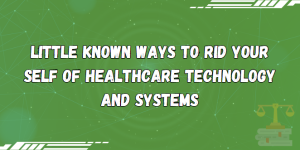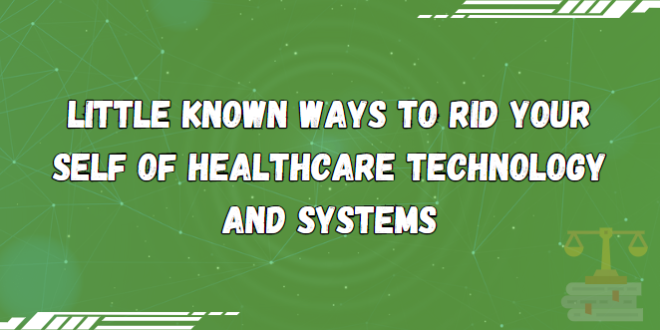Healthcare technology and systems play a vital role in the modern healthcare industry, improving patient care, streamlining operations, and advancing medical research. However, there are times when certain technologies or systems may no longer serve their intended purpose or become outdated. In this article, we will explore some little-known ways to rid yourself of healthcare technology and systems that are no longer beneficial or relevant to your healthcare organization.

1. Evaluate System Effectiveness
The first step in getting rid of healthcare technology and systems is to evaluate their effectiveness. Assess whether the technology or system is meeting your organization’s needs, improving efficiency, and enhancing patient outcomes. If it’s not delivering the expected results, it may be time to consider alternatives.
2. Conduct a Cost-Benefit Analysis
Performing a cost-benefit analysis can help determine whether it’s financially viable to continue using a particular technology or system. Consider the upfront and ongoing costs, maintenance expenses, and potential return on investment. If the costs outweigh the benefits, it may be more prudent to let go of the technology or system.
3. Explore Upgraded Solutions
Technology is ever-evolving, and there may be upgraded solutions available that offer improved functionality and features. Research and explore alternative technologies or systems that can better meet your organization’s needs. Upgrading to a more advanced solution can help you stay ahead in the rapidly changing healthcare landscape.
4. Consider Compatibility
When contemplating getting rid of healthcare technology or systems, consider compatibility issues. Determine whether the existing technology or system integrates well with other systems and workflows. Incompatibility can hinder efficiency and create unnecessary complexities. If compatibility issues persist, it may be time to seek alternatives.
5. Seek User Feedback
Obtaining feedback from users, such as healthcare professionals and staff members, is invaluable in assessing the usability and effectiveness of a technology or system. Conduct surveys, interviews, or focus groups to gather insights on their experiences and identify any pain points or areas for improvement. Their feedback can guide your decision to retain or replace the technology or system.
6. Plan for Transition and Training
When phasing out healthcare technology or systems, it’s crucial to have a comprehensive transition plan in place. Consider the logistics of implementing new technology or systems, including data migration, staff training, and change management. Adequate preparation and training can help facilitate a smooth transition and minimize disruptions.
7. Collaborate with Vendors
If you’re planning to replace a specific healthcare technology or system, collaborate with the vendors or suppliers. Discuss your requirements, challenges, and expectations, and explore possible solutions. Vendors may provide insights or offer alternative options that better align with your organization’s needs.
8. Ensure Data Security
When retiring healthcare technology or systems, data security should be a top priority. Ensure that sensitive patient information and data are securely transferred or disposed of according to relevant privacy and security regulations. Implement proper data sanitization practices to safeguard patient confidentiality.
9. Monitor Industry Trends
Staying informed about emerging healthcare technology trends and industry developments is essential. Regularly monitor industry publications, attend conferences or webinars, and engage with industry experts to gain insights into the latest advancements. This knowledge can help you identify obsolete technologies or systems that should be phased out.
10. Consider Cloud-Based Solutions
Cloud-based solutions offer scalability, flexibility, and cost-effectiveness, making them attractive alternatives to traditional healthcare technology and systems. Consider migrating certain functions or data to the cloud, which can reduce infrastructure costs and simplify system management.
Conclusion
Letting go of outdated or ineffective healthcare technology and systems requires careful evaluation, planning, and consideration of alternatives. By following the little-known ways discussed in this article, you can make informed decisions that optimize your healthcare organization’s operations and patient care. Embrace the ever-evolving landscape of healthcare technology and bid farewell to systems that no longer serve you well.
Until next time!
We hope this article provided you with valuable insights into how to rid yourself of healthcare technology and systems that are no longer beneficial. Stay tuned for more engaging articles in the future. Goodbye for now!
 Spacetimes A collection of the latest news and information from various trusted sources
Spacetimes A collection of the latest news and information from various trusted sources
